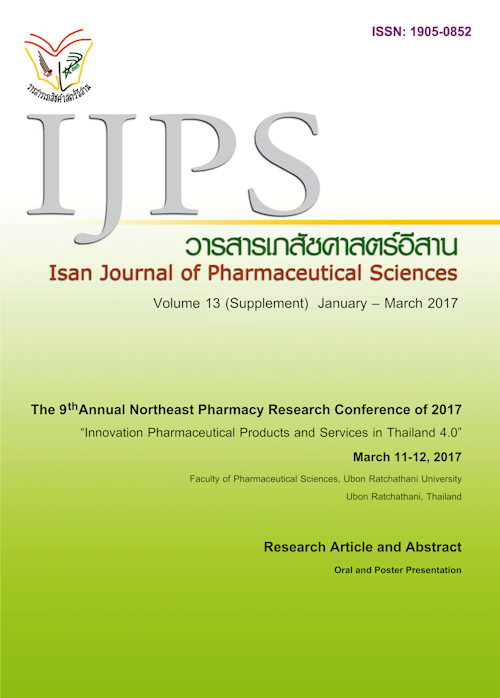Determination of lead in cosmetics using atomic absorption spectrophotometry
Main Article Content
Abstract
Introduction: This study investigated the level of lead (Pb), a heavy metal which was possible to contaminate in cosmetic samples. All samples were classified into four groups; eye shadow, hair dye, eye linear and beauty soap. Announcement of The Ministry of Public Health (the component name not to be used as an ingredient in cosmetics), BE2559 (2016), Thailand, indicated that the safety level for lead contamination should not be higher than 20 ppm by weight. The technique for this studied was atomic absorption spectrophotometric method. Methods: The cosmetic samples were prepared using digestion technique with nitric acid. The clear solution of digested samples was determined for lead (Pb) level by investigating light absorption of lead free atom. The appropriate wavelength was at 283.31 nm. The calibration curve was linear over the range of 0.25 V 3.0 μg mL-1 lead standard solution. These samples were analyzed triplicate. Results: From 80 cosmetic sample, it was found that the highest average lead level obtained from eye shadow sample. The lead levels was shown in the range of 1.58 V 17.53, V 0.001.19, 0.00 V 7.07 and 0.05 V 1.17 μg g-1 for eye shadow, hair dye, eye linear and beauty soap, respectively. The average lead level were found to be 4.88, 0.30, 1.07 and 0.64 μg g-1 for eye shadow, hair dye, eye linear and beauty soap, respectively. Conclusion: All lead levels in this study were not higher than the safety limit of announcement from The Ministry of Public Health, Thailand.
Article Details
In the case that some parts are used by others The author must Confirm that obtaining permission to use some of the original authors. And must attach evidence That the permission has been included
References
Announcement of the Food and Drug Administration’s Statement of the Ministry of Public Health (the component name not to be used as an ingredient in cosmetics), Thailand, BE 2559 (2016); page 13.
ASEAN Cosmetic Directive [online]. [Cited 2017 Mar 13]. Available from: http://has.gov.sg/content/hsa/en/Health_Products_Regulation/Cosmetic_Products/Overview/ASEN_Cosmetic_Directive.html
Bocca B, Pino A, Alimonti A, Forte G. Toxic metals contained in cosmetics. Regul Toxicol Pharm. 2014; 68: 447-467.
EU, European Union. Council Directive 76/768/EEC on the approximation of the laws of the member states relating to cosmetic products. Official Journal L. 1976; 262: p.169 .
Khantivong, C. Heavy metals level contamination in traditional medicine from Lao PDR. A thesis for the degree of Master of Science in Pharmaceutical Chemistry and Natural Products, Khon Kaen University, 2016.
Ozbek N, Akman S. Determination of lead, cadmium and nickel in hennas and other hair dyes sold in Turkey. Regul Toxicol Pharm. 2016; 79: 46-53.
Panigati M, Piccone M, D’ Alfonso G, Orioli M, Carini M. Determination of lead and cadmium in titanium dioxide by differential pulse anodic stripping voltammetry. Talanta. 2002; 58: 481-488.
Salvador A, Chisvert A. Analysis of cosmetic products. Amsterdam, Elsevier, 2007.
Sani A, Gaya MB, Abubakar FA. Determination of some heavy metals in selected cosmetic products sold in Kano metropolis, Nigeria. Toxicol Rep. 2016; 3: 866-869.
Soares AR, Nascentes CC. Development of a simple method for the determination of lead in lipstick using alkaline solubilization and graphite furnace atomic absorption spectrometry. Talanta. 2013; 105: 272-277.
Volpe MG, Nazzaro M, Coppola R, rapuano F, Aquino RP. Determination and assessments of selected heavy metals in eye shadow cosmetics from China, Italy and USA. Microchem J. 2012; 101: 65-69.


